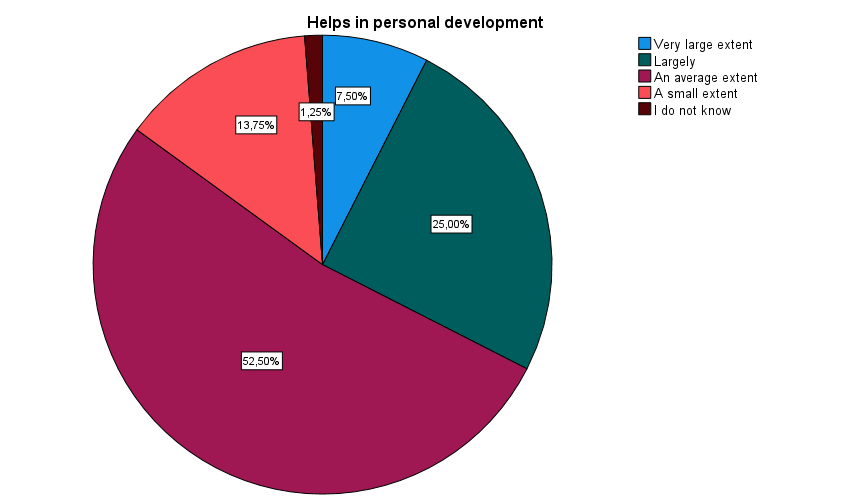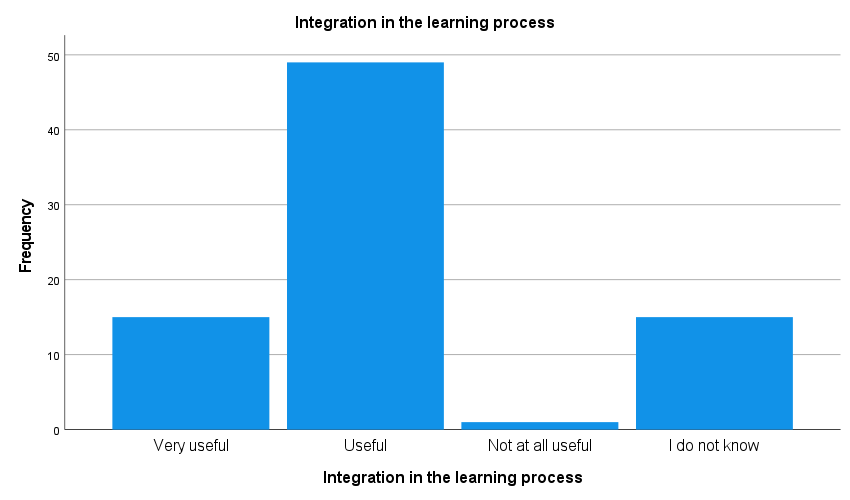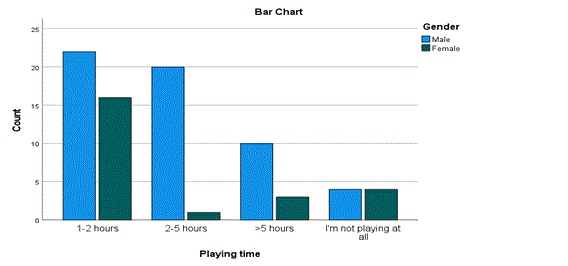Abstract
In a world in continuous change, individuals develop a range of skills not only in a formal context but more and more often in an informal context. Today, video games represent one of the most interesting and attractive ways of fun and leisure for young people of different ages from all over the world. In addition to the entertainment potential, in recent years, they have also aroused the interest of education researchers, who also analysed them from the perspective of their impact on students' cognitive ability. Thus, through video games young people of different ages are involved, unintentionally and in an informal setting, in a learning process that is very different from the traditional one and which is often not apparent. Through games, a series of soft skills are developed: relationship, communication, adaptability, decision making. The paper represents a quantitative study in which the opinion of students from a technical faculty regarding video games and how they help develop soft skills which in turn are used in the learning process is pursued. The students are questioned about the skills they develop by playing video games and the benefits they have, and which are useful in learning were analyzed. Also, the disadvantages that students feel in terms of video games and their implications on learning were identified.
Keywords: Gamification, learning, soft skills, video games
Introduction
The traditional lecture-based education that primarily pursues the deductive transmission of information has been restructured due primarily to everyone's access to technology and a new generation of students who easily use technology.
Recent studies (Srinivasan et al., 2008) indicate that traditional learning methods cannot be applied to new generations of students. These students, a generation with a gamers' mindset - learn in a completely different way, meaning they’ll treat the world as a place for creation, not consumption (Lawson & Lawson, 2010).
Thus, a new way of learning is configured, in which students become creators of information and not consumers, and in this new context video games will have a very important role. Passionate about video games, they enter a world where they can be what they want, they can create what they want. With the growing popularity of video games, a huge entertainment industry has developed around them.
A number of studies (Brand et al., 2003; Hainey et al., 2016) indicate that although video games were originally created for relaxation, fun, they quickly crossed the boundaries of entertainment being integrated in other fields: education, health, military, business (entrepreneurship).
The development of ICT tools, the emergence of commercial video games and then educational ones, have an important role in promoting effective education (Saghir, 2016). It must be accepted that gaming has an integral part to play in their informal learning (Moline, 2010).
A new term appears in literature – gamification - which involves the application of game-specific elements (competition, scores, game rules) in other life situations (marketing techniques, non-game situations, in business to improve employee involvement in marketing). Given all this, the integration of video game elements in formal learning has become just a matter of time.
Students' interest in participating in game-based lessons should not be neglected as they are willing to actively participate in their implementation. By the skills acquired through games, they immediately understand the rules and stages involved in using this technique.
When students play computer games, they are involved in an active learning environment which contributes to the active assimilation of new information (Kah, 2011). The passion with which they play computer games, the total involvement in the game can be capitalized in education.
Since most people spend a lot of time in front of the computer, playing games either individually or in teams, the interest of educators and researchers in education has focused on identifying ways to use computer games to improve learning. Due to cognitive abilities different from those of previous generations, the gamer generation also aroused the interest of parents, teachers and researchers.
While parents are concerned with reducing the time allotted by students for video games, there are teachers who see it as a challenge and are busy finding ways to integrate it into teaching.
The use of video games as a learning tool is quite controversial and insufficiently studied. However, integrating video games into the learning process can have huge potential in increasing learning efficiency (Griffiths, 2002). Thus, the learning process can be compared to a video game that has certain rules, which the student must follow, has levels that must be exceeded with high scores, and where there are rewards, both during the game and at the end of each level.
Not only do educational games impact students' cognitive development, but all games also help them learn to make decisions, use strategies, anticipate consequences, and express their personalities. Matthew Barr suggests that commercial video games may be used to develop useful skills and competencies in undergraduate students (Barr, 2017).
Through video games several skills considered in the current context such as problem solving, communication, resourcefulness or adaptability, which are considered desirable in graduates, particularly where employability is concerned are developed (Barr, 2017).
There are studies that analyze the positive or negative effects of video games on both student behavior and learning (Quwaider et al., 2019). The use of video games in learning has a number of benefits (Barr, 2017).
- Develops the ability to negotiate, plan and encourages them to try different approaches to advance in the game.
- Develops creativity, there are games in which players change the characters, create personalized looks (through outfit, hairstyle, new weapons).
- Active participation in the game, by changing characters, creating new levels - demonstrates a deep understanding of the rules of the game and the relationships between people.
- Can be used in problem solving (creates plans and solves problems).
- Develops interest in history, geography, culture (historical games), which should be exploited by parents and supplemented with visits to museums.
- Develop the ability to relate and socialize. Although apparently, children spend a lot of time alone in front of the computer, playing games on networks, students make new friends, they can communicate on other topics than those of the game. It is interesting that those with reduced communication skills in real life, in an online environment, eliminate this disability (Barr, 2018).
- Develops a competitive environment for those who, for example, are not competitive in real life.
- Develop leadership skills. In the virtual environment leaders are chosen according to other criteria than in the real environment. Age doesn’t matter, but how skilled you are to lead the extremely heterogeneous team (both as a age and as a gender) to victory, to mediate the conflicts that have arisen.
All these benefits gained by students through play can be used by teachers in learning. This presupposes that the teacher is himself a player (having played at least one or 2 games) in order to know directly the potential of the video game and to understand how a video game learning experience can be realized (Moline, 2010).
Problem Statement
Using gamification as a learning strategy can lead to increased student involvement in learning. By taking elements of the game and extrapolating them to the classroom, the lessons will become much more fun and motivating.
Obviously, a few limitations / disadvantages of using video games are identified and the first aspect is related to their excessive use. Players become enthusiastic and involved in the game, which can affect their motivation and interest in participating in real-world activities. As games change rapidly, new versions appear, new challenges, studies on their impact are difficult to achieve (Griffiths, 2002).
Research Questions
As a consequence of the information previously presented, the following question are emerging: Does the integration of video games in the lesson lead to an increase in learning outcomes?
Purpose of the Study
The purpose of this paper is to analyses how students perceive video games. In order to achieve this goal, the aim was to identify the impact of computer games on learning, then identify some of the skills that can be developed.
Research Methods
In carrying out this micro-research, a method of quantitative analysis was used, the survey based on a questionnaire. For this purpose, a questionnaire composed of 12 items was developed. The application of the questionnaire and the data collection were done online, with the help of the Google Forms application. Using this, the opinion of students was followed regarding video games and the way in which they form a series of skills used in learning. The questionnaire included items related to age and gender and an open item.
The collected data were processing using the SPSS (Statistical Package for Social Sciences) program and descriptive and correlational analyses were realized. The Likert Scale was used with five values. Also, the analysis of the frequency distribution series, the calculation of the mean and standard deviation (S.D.) and the statistical analysis of the frequency connections was performed (Pearson correlation and the parametric correlation coefficient, r).
The study was conducted on a sample of 80 respondents (N = 80) aged between 14-25 years. The distribution of the group of subjects by gender and age is presented in Table 1. It is observed that the majority is composed of teenagers, which leads to change the assumption about video games to be just for entertaining or for time-consuming (Quwaider et al., 2019).
Findings
All surveyed students play different computer games. In a first item of the study, the passion for computer games was questioned. 86.3% of those surveyed said they are passionate about computer games, most of them are boys (76.8%).
Of the 86.8% of respondents who said they are passionate about video games, 47.8% said they play 1-2 hours a day, 30.4% between 2-5 hours a day (Table 2), fact confirmed by other studies (Srinivasan et al., 2008). In the same study it is estimated that the typical college student plays almost 2 hours of video games per day. Mark Prensky refers to this new generation of learners as „The Gamer Generation” .
An alarmingly high percentage (16.3%) of respondents admitted that they play for more than 5 hours, which is excessive. And those who admit that they are not passionate about playing for around 1-2 hours. Interestingly, 10% said they did not play at all. Also, boys play more than girls (Figure 1). There is a significant correlation between the gender and video game enthusiasts (Table 3). Boys are more passionate than girls. And spend more time playing the game than the girls.

Asked what skills they developed as a result of the games, the following answers were receive:
- 72,5% have learned a foreign language;
- 63,7% are of a mind that they have developed their distributive attention;
- 62,5% are faster at decision making;
- 55% develop teamwork skills;
- 37,5 % sharpened their mathematical thinking;
- 50% have developed their general culture.
Asked how games affect learning, the students’ opinions are divided, but somewhat equal. A percentage of 28.7% of the respondents consider that they have developed skills that facilitate their learning while 32.5% admit that they distract them from learning, and a rather high percentage 38% state that they do not influence their learning. For this item (N=80), SD=0.821, M=2,10 (Table 4).
There is no significant correlation between playing time and the influence of the learning process (Table 5).
Another question was, how video games help them in their personal development. 52,5% of respondents believe that games help them an average extent in their personal development, and only 7.5% think it helps them a lot (Figure 2).

A very high percentage considers the integration of video games in the lesson very useful and useful (81.1%), which would probably increase the attractiveness of teaching activities (Figure 3).

There is a weak correlation between the integration of video games in the lesson and their influence on learning outcomes, practically no correlation can be made (Table 6).
Regarding the benefits of video games in learning most consider that it develops attention (76,3%), stimulates creativity (62,5%), an attractive method of learning (53,8%). The main disadvantage, recognized by over 80% of them is addiction, but I agree that it can also affect their health and cause superficial learning, not being able to stay focused on the task for a long time. Also, over 2% of them consider that video games create behavioral disorders.
Asked if computer games have affected their learning outcomes, 67.5% consider that their school results have not been affected by the fact that they play on the computer. Invited to offer details on how they were affected, the responses to this open item were as follows:
Sometimes I wasted my time playing a game instead of learning.
I had periods when they distracted me and I neglected everything related to school.
Giving a longer playing time, led to a reduction in learning time. Which was felt in the decrease of school results.
The computer obsession makes me go homework-free and without going to school
They distracted me
Some of them consider that their computer gaming performance has not been affected because:
I still had good results.
I kept a balance between learning and games.
I knew how to do each one.
Computer games influence school results if you spend time with them at the expense of study.
I knew how to divide my time so as not to ruin my grades.
I knew how to manage my time and I kept a slightly inclined balance towards learning.
Conclusions
Video games are part of students' lives. The surveyed students spend quite a lot of time on the computer. They believe that in this way they develop their communication skills (including in a foreign language), they develop their distributive attention, they work in a team, they can make decisions faster or they have developed their general culture.
Developing attention, spatial vision, increased curiosity, collaborative work, which are acquired during games and can be used in learning (Saghir, 2016).
They want to be integrated in teaching activities because they are engaging, attractive and interactive. The main reasons why video games can be used in the classroom are those related to capturing students' attention and increasing their motivation to learn (Tugluk, 2010).
From the present study we can say that there is some correlation between the integration of video games in the lesson and their influence on the outcomes of learning.
The students are also aware of the disadvantages of computer games: can be addictive, decreased learning outcomes, superficiality in learning.
However, there have been opinions advocating for moderation and balance, which would only lead to benefits for users.
References
Barr, M. (2017). Video games can develop graduate skills in higher education students: A randomised trial. Computers & Education, 113, 86–97.
Barr, M. (2018). Student attitudes to games-based skills development: Learning from video games in higher education. Computers in Human Behavior, 80(80 (2018) 283e294), 283–294.
Brand, J. E., Knight, S., & Majewski, J. (2003). The diverse worlds of computer games: a content analysis of spaces, populations, styles and narratives. DIGRA ’03 - PROCEEDINGS of the 2003 DIGRA INTERNATIONAL CONFERENCE: LEVEL UP, 2. http://www.digra.org/wp-content/uploads/digital-library/05150.06387.pdf
Griffiths, M. (2002). The educational benefits of videogames. Education and Health, 20(3), 47-51. https://www.researchgate.net/publication/284491180_The_educational_benefits_of_videogames
Hainey, T., Connolly, T. M., Boyle, E. A., Wilson, A., & Razak, A. (2016). A systematic literature review of games-based learning empirical evidence in primary education. Computers & Education, 102(102), 202–223.
Kah, C. (2011). Constructionist learning through serious games. Proceedings of the 7th Australasian Conference on Interactive Entertainment. https://www.researchgate.net/publication/262206275_Constructionist_learning_through_serious_games
Lawson, C., & Lawson, L. L. (2010). Adventures in Learning: Creating Role Playing Video Games to Teach and Learn Economics. International Review of Economics Education, 9(1), 93-110.
Moline, T. (2010). Video Games as Digital Learning Resources: Implications for Teacher-Librarians and For Researchers. School Libraries Worldwide, 16(2). https://journals.library.ualberta.ca/slw/index.php/slw/article/view/6804/3802
Prenski, M. (2001). Digital game - based learning McGraw Hill, New York. https://marcprensky.com/writing/Prensky%20-%20Ch2-Digital%20Game-Based%20Learning.pdf
Quwaider, M., Alabed, A., & Duwairi, R. (2019). The Impact of Video Games on the Players Behaviors: A Survey. The 10th International Conference on Ambient Systems, Networks and Technologies (ANT), Procedia Computer Science 151, 575–582.
Saghir, A. (2016). Influence of Video Games in Learning. Journal of Emerging Trends in Computing and Information Sciences, 7(8), 338-342. http://www.cisjournal.org/journalofcomputing/archive/vol7no8/vol7no8_1.pdf
Srinivasan, V., Butler-Purry, K., & Pedersen, S. (2008). Using video games to enhance learning in digital systems. Proceedings of the 2008 Conference on Future Play Research, Play, Share - Future Play ’08.
Tugluk, M. N. (2010). Analysis of multi-user video games in teacher training. Procedia Social and Behavioral Sciences, 2(2), 2514-2516.
Copyright information

This work is licensed under a Creative Commons Attribution-NonCommercial-NoDerivatives 4.0 International License.
About this article
Publication Date
10 April 2023
Article Doi
eBook ISBN
978-1-80296-961-0
Publisher
European Publisher
Volume
5
Print ISBN (optional)
-
Edition Number
1st Edition
Pages
1-1463
Subjects
Education sciences, teacher education, curriculum development, educational policies and management
Cite this article as:
Gabriela Carmen, O. (2023). Video Games and Their Influence on the Learning Process. In E. Soare, & C. Langa (Eds.), Education Facing Contemporary World Issues - EDU WORLD 2022, vol 5. European Proceedings of Educational Sciences (pp. 117-125). European Publisher. https://doi.org/10.15405/epes.23045.12

